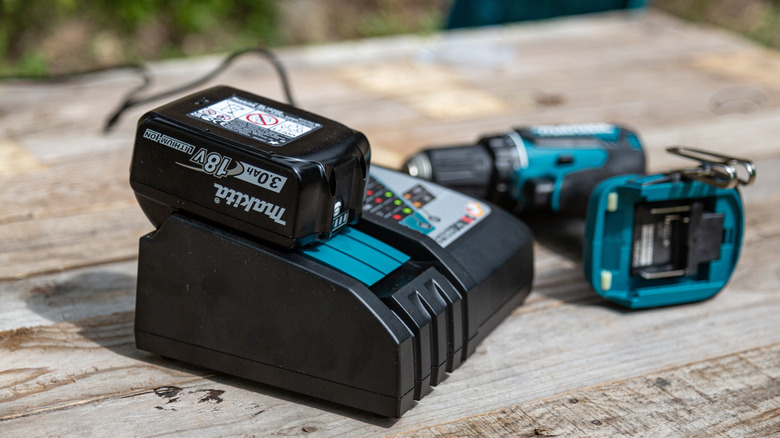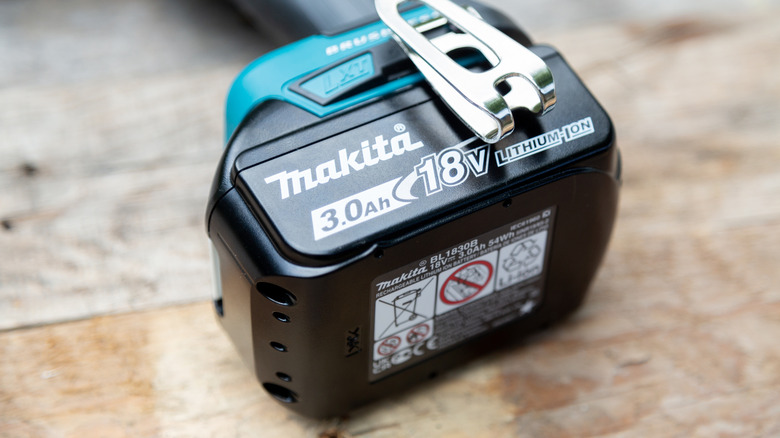Why Your Makita Battery Isn't Charging And How To Troubleshoot It
When considering which are the best power tool brands for homeowners, Makita is a popular selection. This is an impressive brand where the manufacturer's history in producing and repairing electric motors translates well to creating long-lasting and reliable motors in its power tools. Makita uses high-quality components and materials that are built to last. The same goes for its power tool batteries. Makita batteries have excellent reliability and longevity.
However, you may occasionally have problems with Makita rechargeable batteries refusing to work as expected. Overheating or a shorter-than-expected usage life are potential problems you may run into. Storing the battery in an extreme temperature environment is a common mistake that shortens the life of power tool batteries. When the battery simply won't charge, though, this is one of the most common problems across all cordless power tool brands, including Makita. It can be challenging to diagnose the reason why the battery won't charge because there are so many different potential causes, from placing the battery on the charger incorrectly to a battery that is simply too worn out.
Because of the quality of the manufacturing, it's best to try out maintenance tips to keep your Makita power tools working their best rather than just scrapping them entirely. The same goes for the rechargeable batteries, and thankfully, most of the solutions to your charging problem are fairly simple.
Troubleshooting issues with Makita rechargeable batteries
A common reason a battery is not charging is because it's not on the charger correctly. The Makita battery should slide into place horizontally and make a clicking sound when it's properly inserted. If it goes in crookedly or doesn't make the audible click, it probably won't charge as expected.
Check the contact points on the rechargeable battery, which are the metal points that allow electrical power to pass from the charger to the rechargeable battery. If these metal contacts are dirty or corroded, the contacts cannot make a secure connection with the charger. You can brush the battery's connector slots with a stiff bristle brush to try to dislodge any solid particles interfering with the connection. To clean grime from the metal terminals, wipe them down with a dry cloth.
You should also try to avoid charging the Makita batteries in areas with extreme hot or cold temperatures. Some can withstand temperatures between 32 and 113 degrees Fahrenheit, while others only charge properly in an ambient temperature range of 50 to 104 degrees Fahrenheit. Check the safety guidelines for your size of battery. The battery's internal resistance increases when charging in cold weather, which significantly prolongs the charging time, potentially making it appear as though the unit is not charging. If it's too hot, you could experience thermal runaway in lithium-ion batteries, which is a situation where the case could rupture and lead to a thermal explosion and fire.
Issues with the Makita charger unit that could prevent the battery from charging
To test the viability of the Makita battery charger, plug it into an electrical outlet. The indicator lights should be green, showing that the unit is receiving power and is ready for you to insert a battery. If it isn't lighting up as expected, try the charger in another outlet. You can also test the original outlet by plugging in another device. Although it may sound silly, make sure the unit is plugged tightly into the outlet before you assume that it's broken.
If you believe the charger is the issue, the indicator lights can give you a clue to the problem the charger is having. In most cases, the indicator lights will alternate between red and green flashing to show a problem. If the indicator lights are blinking repeatedly, the charger may have gone into overheat protection mode. When the battery is overheated, the charger will not charge it until the battery cools. To determine whether the problem is with the charger or battery, try another Makita battery. If it also won't charge, the problem is likely with the charger.
When you have particles in the grooves of the charger, it could prevent the battery from charging. When you're doing DIY projects, sawdust may block the terminal connections, for example. Use a stiff brush to remove any particles from the grooves and connectors.


